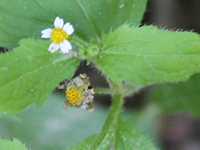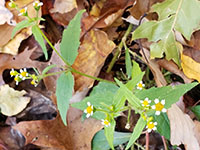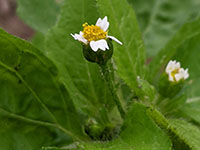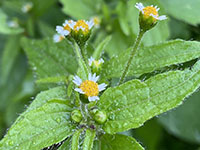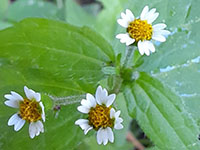![]()
Hairy Galinsoga is a species of flowering plant in the aster family originating in central Mexico, although it has become naturalized in many other places such as North and South America, Europe, Japan, Philippines, and Northern India. Hairy galinsoga is considered a weed throughout its native and introduced range. As an agricultural weed, hairy galinsoga can reduce crop yields by up to 50%. The genus name commemorates Spanish physician and botanist Mariano Martinez de Galinsoga (1766-1797). The species name comes from the Latin words quadri, "square" and radiatus, "with shining rays".
![]()
There are currently no commercial applications for hairy galinsoga.
![]() Within the realm of rational and holistic medicine, hairy galinsoga, when rubbed onto the body, is useful in treating nettle stings. The juice of the hairy galinsoga plant is applied to treat wounds; It can help to coagulate the blood of fresh cuts and wounds.
Within the realm of rational and holistic medicine, hairy galinsoga, when rubbed onto the body, is useful in treating nettle stings. The juice of the hairy galinsoga plant is applied to treat wounds; It can help to coagulate the blood of fresh cuts and wounds.
Please note that MIROFOSS does not suggest in any way that plants should be used in place of proper medical and psychological care. This information is provided here as a reference only.
![]()
The leaves, stem and flowering shoots of hairy galinsoga can be eaten, raw or cooked, as a potherb, or added to soups and stews. Hairy Galinsoga can be dried and ground into a powder then used as a flavouring in soups and stews. Having a bland but acceptable taste, hairy galinsoga can be used in salad either on its own or mixed with other leaves. The fresh juice can be mixed and drunk with tomato or vegetable juices.
Please note that MIROFOSS can not take any responsibility for any adverse effects from the consumption of plant species which are found in the wild. This information is provided here as a reference only.
![]()
Hairy Galinsoga is native to Mexico and Peru, but has naturalized in many parts of the world. Hairy Galinsoga can be found growing along roadsides, in waste places and gardens. Suitable for: light (sandy), medium (loamy) and heavy (clay) soils. Suitable pH: acid, neutral and basic (alkaline) soils. It can grow in semi-shade (light woodland) or no shade. It prefers moist soil.
| Soil Conditions | |
| Soil Moisture | |
| Sunlight | |
| Notes: |
![]()
Hairy Galinsoga is an annual herb which can sometimes vary in appearance. The main stem can reach from 10cm to 60cm in height and may have multiple branches attached. Leaves are opposite, oval to triangular or lance-shaped. The leaves can be 2cm to 6cm long and 1cm to 5cm wide. Both surfaces of the leaves are hairy with a coarsely toothed margin. The small flowers are white to pale pink and approximately 1cm wide. Each flower contains eight to fifty yellow bracts with sticky hairs. The plant produces dark brown or black seeds 1.5mm to 3mm in size with 15 to 20 grayish white scales which act as pappus.
![]()
| Plant Height | 10cm to 60cm | 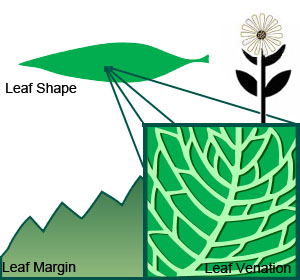 |
| Habitat | Fields, Roadsides, Waste places, Gardens | |
| Leaves | Lanceolate | |
| Leaf Margin | Dentate | |
| Leaf Venation | Cross-Venulate | |
| Stems | Hairy Stems | |
| Flowering Season | May to October | |
| Flower Type | Small sized ray flowers | |
| Flower Colour | White with Yellow Bracts | |
| Pollination | Bees, Self Fertile | |
| Flower Gender | Flowers are hermaphrodite and the plants are self-fertile | |
| Fruit | Seeds with Pappus | |
| USDA Zone | 4B (-28.9°C to -31.6°C) cold weather limit |
![]()
The following health hazards should be noted when handling or choosing a location to hairy galinsoga:
 |
ENVIRONMENTAL HAZARD |
![]()
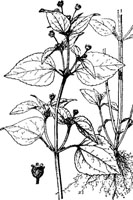 |
-Click here- or on the thumbnail image to see an artist rendering, from The Chinese Department of Agriculture, of hairy galinsoga. (This image will open in a new browser tab) |
![]()
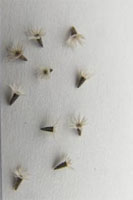 |
-Click here- or on the thumbnail image to see a magnified view, from The Canadian Ministry Agriculture, of the seeds created by hairy galinsoga for propagation. (This image will open in a new browser tab) |
![]()
Hairy Galinsoga can be referenced in certain current and historical texts under the following four names:
Hairy Galinsoga can be translated into the following select languages:
| Arabic | Bulgarian | Chinese (Sim) | 多毛辣子 | ||
| Croatian | Czech | Danish | |||
| Dutch | Esperanto | Estonian | karvane Võõrkakar | ||
| Finnish | French | German | |||
| Greek | Hebrew | Hungarian | szőrös gombvirág | ||
| Italian | Japanese | ハキダメギク | Korean | 털 별꽃 아재비 속 | |
| Low Saxon | Lithuanian | Norwegian | |||
| Persian | Polish | Portuguese | |||
| Romanian | Galin păros | Russian | Slovak | ||
| Spanish | Swedish | Tagalog | |||
| Turkish | Ukrainian | Vietnamese |

![]()
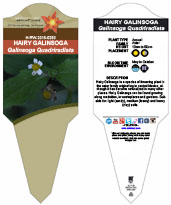 |
The MIROFOSS database offers free printable garden tags for personal and non-profit use. These tags can be used to properly identify plant samples in a garden. Click on the tags shown on the the screen or -click here- to download a full size jpeg image for a hairy galinsoga identification tag; which can be printed on paper or used with a plastic laser printer. |
 |
What's this? What can I do with it? |
![]()
| Description | Kartesz, J.T. 1994. A synonymized checklist of the vascular flora of the United States, Canada, and Greenland. 2nd edition. 2 vols. Timber Press, Portland, OR |
| Description | Adams, C. D. 1972. Flowering plants of Jamaica. University of the West Indies, Jamaica. 848pp. |
| Biology | Gary N. Ervin, John D. Madsen & Ryan M. Wersal. "Galinsoga quadriradiata Cav.". Mississippi State University. |
| Biology | Rhoads, Block. The Plants of Pennsylvania (2 ed.). ISBN 978-0-8122-4003-0. |
| Biology | Dickinson, T.; Metsger, D.; Bull, J.; & Dickinson, R. (2004) ROM Field Guide to Wildflowers of Ontario. Toronto:Royal Ontario Museum, |
| Image Rendering | USDA-NRCS PLANTS Database / USDA NRCS. Wetland flora: Field office illustrated guide to plant species. USDA Natural Resources Conservation Service. |
| Environment | National Audubon Society. Field Guide To Wildflowers (Eastern Region): Alfred A. Knopf. ISBN 0-375-40232-2 |
| Physical Identification | National Audubon Society. Field Guide To Wildflowers (Eastern Region): Alfred A. Knopf. ISBN 0-375-40232-2 |
| June 24, 2016 | The last time this page was updated |
| ©2025 MIROFOSS™ Foundation | |
 |
|

